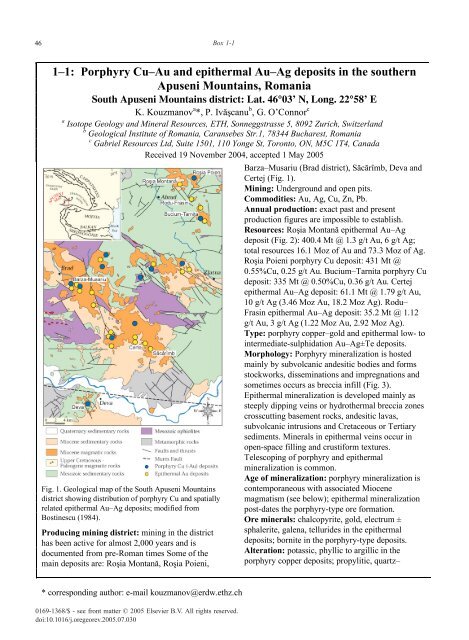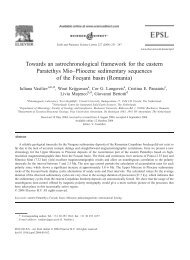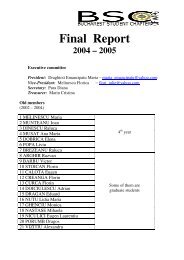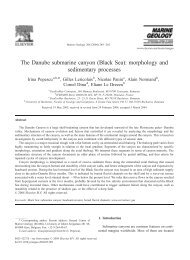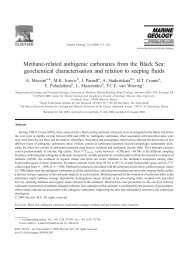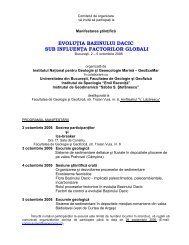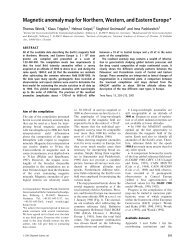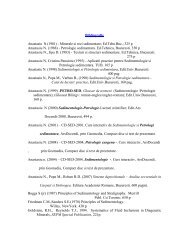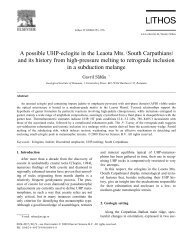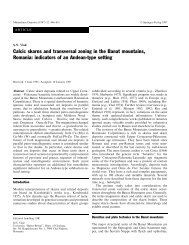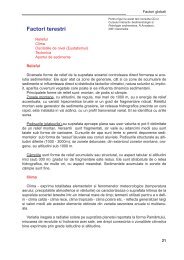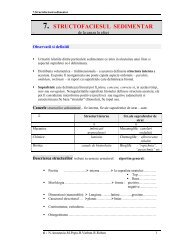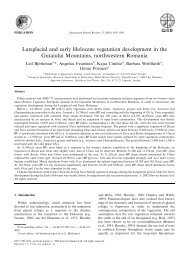1?1: Porphyry Cu?Au and epithermal Au?Ag deposits ... - geo.edu.ro
1?1: Porphyry Cu?Au and epithermal Au?Ag deposits ... - geo.edu.ro
1?1: Porphyry Cu?Au and epithermal Au?Ag deposits ... - geo.edu.ro
Create successful ePaper yourself
Turn your PDF publications into a flip-book with our unique Google optimized e-Paper software.
46<br />
Box 1-1<br />
1–1: <st<strong>ro</strong>ng>Porphyry</st<strong>ro</strong>ng> <st<strong>ro</strong>ng>Cu</st<strong>ro</strong>ng>–<st<strong>ro</strong>ng>Au</st<strong>ro</strong>ng> <st<strong>ro</strong>ng>and</st<strong>ro</strong>ng> <st<strong>ro</strong>ng>epithermal</st<strong>ro</strong>ng> <st<strong>ro</strong>ng>Au</st<strong>ro</strong>ng>–<st<strong>ro</strong>ng>Ag</st<strong>ro</strong>ng> <st<strong>ro</strong>ng>deposits</st<strong>ro</strong>ng> in the southern<br />
Apuseni Mountains, Romania<br />
South Apuseni Mountains district: Lat. 46°03’ N, Long. 22°58’ E<br />
K. Kouzmanov a *, P. Ivăşcanu b , G. O’Connor c<br />
a Isotope Geology <st<strong>ro</strong>ng>and</st<strong>ro</strong>ng> Mineral Resources, ETH, Sonneggstrasse 5, 8092 Zurich, Switzerl<st<strong>ro</strong>ng>and</st<strong>ro</strong>ng><br />
b Geological Institute of Romania, Caransebes Str.1, 78344 Bucharest, Romania<br />
c Gabriel Resources Ltd, Suite 1501, 110 Yonge St, To<strong>ro</strong>nto, ON, M5C 1T4, Canada<br />
Fig. 1. Geological map of the South Apuseni Mountains<br />
district showing distribution of porphyry <st<strong>ro</strong>ng>Cu</st<strong>ro</strong>ng> <st<strong>ro</strong>ng>and</st<strong>ro</strong>ng> spatially<br />
related <st<strong>ro</strong>ng>epithermal</st<strong>ro</strong>ng> <st<strong>ro</strong>ng>Au</st<strong>ro</strong>ng>–<st<strong>ro</strong>ng>Ag</st<strong>ro</strong>ng> <st<strong>ro</strong>ng>deposits</st<strong>ro</strong>ng>; modified f<strong>ro</strong>m<br />
Bostinescu (1984).<br />
P<strong>ro</strong>ducing mining district: mining in the district<br />
has been active for almost 2,000 years <st<strong>ro</strong>ng>and</st<strong>ro</strong>ng> is<br />
documented f<strong>ro</strong>m pre-Roman times Some of the<br />
main <st<strong>ro</strong>ng>deposits</st<strong>ro</strong>ng> are: Roşia Montană, Roşia Poieni,<br />
Received 19 November 2004, accepted 1 May 2005<br />
Barza–Musariu (Brad district), Săcărîmb, Deva <st<strong>ro</strong>ng>and</st<strong>ro</strong>ng><br />
Certej (Fig. 1).<br />
Mining: Underg<strong>ro</strong>und <st<strong>ro</strong>ng>and</st<strong>ro</strong>ng> open pits.<br />
Commodities: <st<strong>ro</strong>ng>Au</st<strong>ro</strong>ng>, <st<strong>ro</strong>ng>Ag</st<strong>ro</strong>ng>, <st<strong>ro</strong>ng>Cu</st<strong>ro</strong>ng>, Zn, Pb.<br />
Annual p<strong>ro</strong>duction: exact past <st<strong>ro</strong>ng>and</st<strong>ro</strong>ng> present<br />
p<strong>ro</strong>duction figures are impossible to establish.<br />
Resources: Roşia Montană <st<strong>ro</strong>ng>epithermal</st<strong>ro</strong>ng> <st<strong>ro</strong>ng>Au</st<strong>ro</strong>ng>–<st<strong>ro</strong>ng>Ag</st<strong>ro</strong>ng><br />
deposit (Fig. 2): 400.4 Mt @ 1.3 g/t <st<strong>ro</strong>ng>Au</st<strong>ro</strong>ng>, 6 g/t <st<strong>ro</strong>ng>Ag</st<strong>ro</strong>ng>;<br />
total resources 16.1 Moz of <st<strong>ro</strong>ng>Au</st<strong>ro</strong>ng> <st<strong>ro</strong>ng>and</st<strong>ro</strong>ng> 73.3 Moz of <st<strong>ro</strong>ng>Ag</st<strong>ro</strong>ng>.<br />
Roşia Poieni porphyry <st<strong>ro</strong>ng>Cu</st<strong>ro</strong>ng> deposit: 431 Mt @<br />
0.55%<st<strong>ro</strong>ng>Cu</st<strong>ro</strong>ng>, 0.25 g/t <st<strong>ro</strong>ng>Au</st<strong>ro</strong>ng>. Bucium–Tarnita porphyry <st<strong>ro</strong>ng>Cu</st<strong>ro</strong>ng><br />
deposit: 335 Mt @ 0.50%<st<strong>ro</strong>ng>Cu</st<strong>ro</strong>ng>, 0.36 g/t <st<strong>ro</strong>ng>Au</st<strong>ro</strong>ng>. Certej<br />
<st<strong>ro</strong>ng>epithermal</st<strong>ro</strong>ng> <st<strong>ro</strong>ng>Au</st<strong>ro</strong>ng>–<st<strong>ro</strong>ng>Ag</st<strong>ro</strong>ng> deposit: 61.1 Mt @ 1.79 g/t <st<strong>ro</strong>ng>Au</st<strong>ro</strong>ng>,<br />
10 g/t <st<strong>ro</strong>ng>Ag</st<strong>ro</strong>ng> (3.46 Moz <st<strong>ro</strong>ng>Au</st<strong>ro</strong>ng>, 18.2 Moz <st<strong>ro</strong>ng>Ag</st<strong>ro</strong>ng>). Rodu–<br />
Frasin <st<strong>ro</strong>ng>epithermal</st<strong>ro</strong>ng> <st<strong>ro</strong>ng>Au</st<strong>ro</strong>ng>–<st<strong>ro</strong>ng>Ag</st<strong>ro</strong>ng> deposit: 35.2 Mt @ 1.12<br />
g/t <st<strong>ro</strong>ng>Au</st<strong>ro</strong>ng>, 3 g/t <st<strong>ro</strong>ng>Ag</st<strong>ro</strong>ng> (1.22 Moz <st<strong>ro</strong>ng>Au</st<strong>ro</strong>ng>, 2.92 Moz <st<strong>ro</strong>ng>Ag</st<strong>ro</strong>ng>).<br />
Type: porphyry copper–gold <st<strong>ro</strong>ng>and</st<strong>ro</strong>ng> <st<strong>ro</strong>ng>epithermal</st<strong>ro</strong>ng> low- to<br />
intermediate-sulphidation <st<strong>ro</strong>ng>Au</st<strong>ro</strong>ng>–<st<strong>ro</strong>ng>Ag</st<strong>ro</strong>ng>±Te <st<strong>ro</strong>ng>deposits</st<strong>ro</strong>ng>.<br />
Morphology: <st<strong>ro</strong>ng>Porphyry</st<strong>ro</strong>ng> mineralization is hosted<br />
mainly by subvolcanic <st<strong>ro</strong>ng>and</st<strong>ro</strong>ng>esitic bodies <st<strong>ro</strong>ng>and</st<strong>ro</strong>ng> forms<br />
stockworks, disseminations <st<strong>ro</strong>ng>and</st<strong>ro</strong>ng> impregnations <st<strong>ro</strong>ng>and</st<strong>ro</strong>ng><br />
sometimes occurs as breccia infill (Fig. 3).<br />
Epithermal mineralization is developed mainly as<br />
steeply dipping veins or hyd<strong>ro</strong>thermal breccia zones<br />
c<strong>ro</strong>sscutting basement <strong>ro</strong>cks, <st<strong>ro</strong>ng>and</st<strong>ro</strong>ng>esitic lavas,<br />
subvolcanic intrusions <st<strong>ro</strong>ng>and</st<strong>ro</strong>ng> Cretaceous or Tertiary<br />
sediments. Minerals in <st<strong>ro</strong>ng>epithermal</st<strong>ro</strong>ng> veins occur in<br />
open-space filling <st<strong>ro</strong>ng>and</st<strong>ro</strong>ng> crustiform textures.<br />
Telescoping of porphyry <st<strong>ro</strong>ng>and</st<strong>ro</strong>ng> <st<strong>ro</strong>ng>epithermal</st<strong>ro</strong>ng><br />
mineralization is common.<br />
<st<strong>ro</strong>ng>Ag</st<strong>ro</strong>ng>e of mineralization: porphyry mineralization is<br />
contemporaneous with associated Miocene<br />
magmatism (see below); <st<strong>ro</strong>ng>epithermal</st<strong>ro</strong>ng> mineralization<br />
post-dates the porphyry-type ore formation.<br />
Ore minerals: chalcopyrite, gold, electrum ±<br />
sphalerite, galena, tellurides in the <st<strong>ro</strong>ng>epithermal</st<strong>ro</strong>ng><br />
<st<strong>ro</strong>ng>deposits</st<strong>ro</strong>ng>; bornite in the porphyry-type <st<strong>ro</strong>ng>deposits</st<strong>ro</strong>ng>.<br />
Alteration: potassic, phyllic to argillic in the<br />
porphyry copper <st<strong>ro</strong>ng>deposits</st<strong>ro</strong>ng>; p<strong>ro</strong>pylitic, quartz–<br />
* corresponding author: e-mail kouzmanov@erdw.ethz.ch<br />
0169-1368/$ - see f<strong>ro</strong>nt matter D 2005 Elsevier B.V. All rights reserved.<br />
doi:10.1016/j.ore<st<strong>ro</strong>ng>geo</st<strong>ro</strong>ng>rev.2005.07.030
Box 1-1 47<br />
Fig. 2. E–W c<strong>ro</strong>ss-section th<strong>ro</strong>ugh the diatreme-hosted Roşia Montană <st<strong>ro</strong>ng>Au</st<strong>ro</strong>ng>–<st<strong>ro</strong>ng>Ag</st<strong>ro</strong>ng> deposit (f<strong>ro</strong>m O’Connor et al., 2003).<br />
Mineralization occurs within an intermediate-sulphidation style <st<strong>ro</strong>ng>epithermal</st<strong>ro</strong>ng> mineralized system, hosted by dacitic intrusions<br />
<st<strong>ro</strong>ng>and</st<strong>ro</strong>ng> associated phreato-magmatic breccias.<br />
Fig. 3. NE–SW c<strong>ro</strong>ss-section th<strong>ro</strong>ugh the Deva porphyry<br />
<st<strong>ro</strong>ng>Cu</st<strong>ro</strong>ng>–<st<strong>ro</strong>ng>Au</st<strong>ro</strong>ng> deposit, consisting of cylindrical 0.5 km diameter<br />
breccia-hosted subvolcanic stock. Mineralization consists<br />
of bornite–chalcopyrite–magnetite stringers <st<strong>ro</strong>ng>and</st<strong>ro</strong>ng><br />
impregnations, p<strong>ro</strong>ducing ore grade up to 2%<st<strong>ro</strong>ng>Cu</st<strong>ro</strong>ng>.<br />
adularia–illite to argillic in the <st<strong>ro</strong>ng>epithermal</st<strong>ro</strong>ng> <st<strong>ro</strong>ng>deposits</st<strong>ro</strong>ng>.<br />
<st<strong>ro</strong>ng>Ag</st<strong>ro</strong>ng>e of host <strong>ro</strong>cks: Miocene, 14.7 to 7.4 Ma, based<br />
on K–Ar dating on whole <strong>ro</strong>ck (Roşu et al., 2004).<br />
Nature of host <strong>ro</strong>cks: calc-alkaline <st<strong>ro</strong>ng>and</st<strong>ro</strong>ng>esites to<br />
dacites, mainly <st<strong>ro</strong>ng>and</st<strong>ro</strong>ng>esites, with subordinate<br />
occurrences of alkaline affinity. Existing stable<br />
isotope analyses (O, H, S, C; Alderton <st<strong>ro</strong>ng>and</st<strong>ro</strong>ng> Fallick,<br />
2000), combined with recent LA–ICP–MS analyses<br />
of fluid inclusions f<strong>ro</strong>m porphyry <st<strong>ro</strong>ng>and</st<strong>ro</strong>ng> <st<strong>ro</strong>ng>epithermal</st<strong>ro</strong>ng><br />
systems in the southern Apuseni Mountains, support<br />
the concept of a dominant magmatic component in<br />
the hyd<strong>ro</strong>thermal fluids of both deposit types.<br />
References<br />
Alderton, D.H.M., Fallick, A.E., 2000. The nature <st<strong>ro</strong>ng>and</st<strong>ro</strong>ng><br />
genesis of gold–silver–tellurium mineralization in the<br />
Metaliferi Mountains of western Romania: Economic<br />
Geology 95, 495–515.<br />
Bostinescu, S., 1984. <st<strong>ro</strong>ng>Porphyry</st<strong>ro</strong>ng> copper systems in the<br />
South Apuseni Mountains, Romania. Annuaire de<br />
l'Institut de Géologie et Géophysique 64, 163–174.<br />
O’Connor, G.V., Minut, A., Leary, S.F., 2003. The<br />
<st<strong>ro</strong>ng>geo</st<strong>ro</strong>ng>logy <st<strong>ro</strong>ng>and</st<strong>ro</strong>ng> exploration of the Roşia Montană gold<br />
deposit, Roşia Montană, Transylvania, Romania. In:<br />
Eliopoulos, D.G. et al. (Eds.), Mineral Exploration <st<strong>ro</strong>ng>and</st<strong>ro</strong>ng><br />
Sustainable Development. Millpress, Rotterdam 2, pp.<br />
1213–1216.<br />
Roşu, E., Seghedi, I., Downes, H., Alderton, D.H.M.,<br />
Szakacs, A., Pecskay, Z., Panaiotu, C., Panaiotu, C.E.,<br />
Nedelcu, L. 2004. Extension-related Miocene calcalkaline<br />
magmatism in the Apuseni Mountains,<br />
Romania: Origin of magmas. Schweizerische<br />
Mineralogische und Pet<strong>ro</strong>graphische Mitteilungen 84,<br />
153–172.


